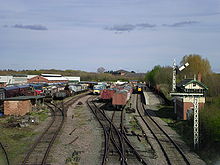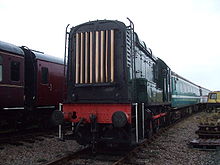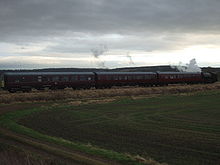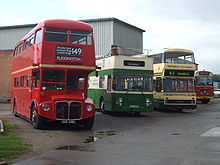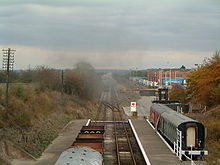- Nottingham Transport Heritage Centre
-
Coordinates: 52°53′5.00″N 1°8′55.00″W / 52.88472°N 1.14861°W
The Nottingham Transport Heritage Centre is a heritage centre based at Ruddington, Nottinghamshire, the terminus of the northern section of the Great Central Railway (GCRN). The site includes locomotive and rolling stock workshops (accessible to the public), as well as cafeteria and shops. Also on-site is a miniature railway operated by the Nottingham Society of Model and Experimental Engineers (NSMEE). The site also has a Model Railway club and building housing local historic buses. Leaving Ruddington Fields station, the railway links Ruddington with East Leake and Loughborough. The Ruddington-Loughborough railway comprises 10 miles.
Contents
Railway collection
The railway operates classic steam / diesel hauled services to Rushcliffe Halt and Loughborough. Most trains are steam-hauled, but our classic heritage diesel collection is one of the best in the midlands. GC Railway Nottingham operate regularly from Easter through to October, and during the winter period ("Santa Specials" before Christmas, and our Winter Gala event post-Christmas). Our train services and Ruddington facilities operate every weekend during all School holidays. As well as regular services, GCRN also operate a host of Special Events and "Gala" days.
Locomotives
- Operational Steam Locomotives
- GWR 3700 Class 3440 City of Truro (Visiting from Gloucestershire Warwickshire Railway. The locomotive is facing chimney first into Ruddington) now doing national tour of preserved lines
- Steam locomotives undergoing overhaul, restoration or repair
- Hudswell Clarke 0-6-0ST No. 54 "Julia". (Undergoing restoration. The Boiler has now been moved to No.1 Shed pending work)
- Manning Wardle 0-6-0ST No. 1762 "Dolobran". (Undergoing restoration. The Locomotive Chassis is facing chimney first into Ruddington)
- Manning Wardle 0-6-0ST No. 2009 "Rhyl". (Undergoing Restoration. Recently moved in doors where work has recommenced in earnest)
- Unrestored and stored steam locomotives
- RSH (Ugly Class) 0-6-0ST No. 56
- RSH (Ugly Class) 0-6-0ST No. 63 "Corby".
- Manning Wardle 0-6-0ST No. 2015 "Arthur". (Awaiting restoration)
- S160 2-8-0 No. 1631. (unrestored, in kit form)
- Main line diesel locomotives
- Class 20 Bo-Bo No. D8007. (BR Green, small yellow ends)
- Class 20 Bo-Bo No. 20154. (BR Green, full yellow ends)
- Class 25 Bo-Bo No. D7629. (Two Tone Green)
- Class 37 Co-Co No. 37340 (37009). (Undergoing restoration to BR Green with full yellow ends)
- Class 47 Co-Co No. 47292. (Variation of large Logo Blue)
- Class 47 Co-Co No. 47765. (RES livery)
- Class 56 Co-Co No. 56097. (BR Trainload Coal)
- Class 73 Bo-Bo No. E6016. (BR(S) Electric Blue)
- Class 46 1Co-Co1 No. 46010. (BR Rail Blue)
- Operational diesel shunters
- Class 08 0-6-0 No. 13180. (BR Green)
- Class 08 0-6-0 No. 08220. (BR Blue)
- Ruston 88DS 4w "Marblaegis". (Ruston Green Livery)
- Simplex 4wd No. 2028 "Morris". (BR Black)
- Ruston 4w No. 371971 "Qwag". (Ruston Green Livery)
- Diesel multiple units
- BR Class 116 hybrid unit 51138+59501+51151 running with Class 117(BR Mid-Brunswick DMU Green)
- BR Class 108 unit 53645+53926. (Under Restoration) (Blue and Grey)
Carriages
- BR Mk1 carriages
- Mk1 RMB (Restaurant Miniature Buffet) 1811 in lined maroon. (Operational)
- Mk1 CK (Composite Corridor) 16168 in unlined maroon livery. (Operational)
- Mk1 CK (Composite Corridor) 16190 in lined maroon livery. (Operational, one side is unlined)
- MK1 BFK (Brake First Corridor)17023 in lined maroon livery (Operational)
- MK1 BSK (Brake Corridor Second)34249 later Derby RTC Laboratory Coach 975046. (now Sold)
- Mk1 TSO (Tourist Standard Open) 4207 in lined maroon livery. (Undergoing overhaul)
- Mk1 RSO (Restaurant Second Open) 1012 later Cinema Coach 150353. (Stored awaiting restoration)
- BR Mk2 carriages
- Mk2 BSO (Brake Standard Open) 9389 ( Operational, lined maroon livery)
- Mk2b TSO 5497 (Operational, painted BR blue and grey)
- Mk2a BSK 35512 (Operational, painted BR blue and grey)
- BR Mk3 carriages
- Mk3 SLEP (Sleeper Coach) 10602.
- Six wheelers
- MSLR 6 wheeler 946. (Undergoing restoration in No.1 shed.)
- MSLR 6 wheeler 373. (Stored)
- GCR Barnum carriages
- GCR Barnum dining coach 664. (Stored)
- GCR Barnum brake coach 695. (Stored)
- GCR Barnum Dining coach 666. (Stored)
- GCR Barnum bar coach 228. (Stored)
- Other carriages
- GCR Clerestory brake coach 1663. (Stored)
- GCR Suburban brake coach 555. (Stored)
- GCR Suburban composite coach 799. (Stored)
- Non-passenger carrying stock
- BR Mk1 GUV (General Utility Van) 86565.
- BR Mk1 GUV (General Utility Van) 86129.
Wagons
- Brake vans
- GWR 20-ton Toad Brake Van 68500 built in 1947. (Part way through overhaul, painted GWR Grey)
- LMS 20-ton Brake Van 357488 built in 1926. (painted BR Bauxite with LMS lettering)
- BR 20-ton Brake Van 952282 built in 1954. (Operational, painted BR Bauxite)
- LMS 20-ton Brake Van 357771 built in 1927. (Awaiting resumption of overhaul)
- BR 20-ton Brake Van 954353 built in 1958. (Operational, painted in BR Bauxite)
- Vans
- BR Palvan 779761 built in 1958. (painted army green)
- BR Widefit 784455 built in 1962. (painted BR Bauxite)
- BR 29-ton VAA 200631 built in 1976.
- BR Widefit 783447 built in 1962. (painted army green)
- BR Palvan 778771 built in 1959. (painted BR Bauxite)
- BR Palvan 776155 built in 1957. (painted army green)
- BR Palvan 782111 built in 1960. (painted army green)
- BR Widefit 783257 built in 1962. (painted army green)
- Railfreight Pressed Steel Box Van 786902.
- Railfreight Pressed Steel Box Van 201055.
- BR Ferry Van 786902 built in 1962.
- Ballast wagons
- BR Dogfish ballast hopper wagon 993039 built in 1959. (Operational, painted BR Black)
- BR Dogfish ballast hopper wagon 983586 built in 1960. (Operational, painted BR Black)
- BR Dogfish ballast hopper wagon 993597 built in 1959. (Operational, painted BR Black)
- BR Dogfish ballast hopper wagon 993230 built in 1957. (Operational, painted BR Black)
- BR Grampus open wagon 991831 built in 1958. (Operational, painted BR Black)
- BR Shark ballast plough 993874 built in 1959. (Operational, painted BR Black)
- Open wagons
- LMS 12-ton open wagon 411453 built in 1937. (painted BR Bauxite)
- Flat wagons
- LMS 50-ton Warwell 721218 built in 1949. (Operational, painted Brown)
- BR Weltrol 900936 built in 1960. (Operational)
- LNER 22 ton Lowmac wagon 230964 (Operational, painted BR Grey)
- BR Bogie Bolster 943545 built in 1953. (pained brown)
- BR Bogie Rail Sturgeon A 994271 built in 1956.
- BR Bogie Rail Sturgeon A 994770 built in 1953.
- BR Weltrol 900937 built in 1960.
- Rail cranes
- LNER Cowans Sheldon 45-tonne Steam Rail Crane 941602 (9017). (painted Lined BR Black with early crest)
Road transport collection
- Operational vehicles
- Leyland Atlantean Nottingham City Transport ARC 666T "Andrew Pickering" built in 1978 (numerous experimental features made this vehicle unique amongst NCT's Atlanteans,)
- AEC Regent III Nottingham City Transport OTV 161 built in 1954.
- Vehicles undergoing light work
- Routemaster RCL London Transport CUV 218C built in 1965. (Notable for being the first RCL Routemaster to be built)
- Leyland Atlantean open-top ex Northern General and Trent ORC 545P built in 1976. (Was also registered MPT 299P and YRC 194 before receiving its present registration)
- Leyland PD1 Barton Transport JVO 230 built in 1948.
- Vehicles undergoing overhaul or restoration
- Barton Transport AEC Reliance/Plaxton Panorama coach 866 HAL built in 1960. (Undergoing restoration)
- Leyland PD1 ex Leicester and Barton DJF 349 built in 1947. (Undergoing restoration)
- Stored vehicles
- Leyland Lion LT5 South Notts VO 8846 built in 1933. (Stored awaiting a major restoration)
- Leyland National Mk.1 Trent Buses KVO 429P built in 1975.
- Leyland Royal Tiger/Duple Roadmaster South Notts MAL 310 built in 1951. (Stored awaiting restoration)
Two locomotives pulling passenger trains on the miniature railway (Note the Crazy Frog picture on the window of the miniature British Rail Class 35)
Miniature railway
The centre is home to a miniature railway, run by the Nottingham Society of Model and Experimental Engineers,[1] which works on the operating days. The line is one mile long and has two running lines, both going through different tunnels. They usually have a miniature railway gala and a miniature traction engine rally during the year.
Model railway
The centre also has three model railway layouts in a portacabin next to the miniature railway. There are two OO gauge layouts; the first is a Thomas the Tank Engine layout and the second is a model of the old Ruddington Station. The third feature, an O gauge layout is a model of a station with a goods and locomotive shed with a Church, woodworking centre and a factory. There is usually a model railway gala each year.
Visitor centre
The visitor centre contains displays about the centre's railway locomotives and vehicles in the road transport collection, the history of freight trains, locomotives and historic bus operators in Nottingham. There are plans to shortly put up displays on the centre's previous life as the Ruddington MOD Depot.
The railway route
Main article: Great Central Railway (preserved)Ruddington is the main station on the line, and the home of the GC Railway Nottingham. It features a road transport building, locomotive sheds, signal box, miniature and model railways, cafe, visitor centre, toilets and car park. The Rushcliffe Country park surrounds the GCRN facilities here. In 2009 the new platform was opened. There is talk of a possible extension from Ruddington towards the River Trent on the outskirts of Nottingham called Nottingham Greenwood.
The gated Asher Lane Crossing is on a private road which was formerly the MOD depot perimeter road. It is a short walk from the country park to the crossing, where it is possible to see trains passing and the crossing keeper at work. There was a set of Sidings here called Asher Lane Sidings, since removed. It is hoped that these could one day be reinstated.
Fifty Steps Bridge is the end of the spur from Ruddington Fields, where trains reverse for the onward journey to Loughborough. The bridge itself originally had "Fifty Steps" but subsequent modifications have increased that number. The former Ruddington station is further north, the trackbed now being owned by the supporting Charity (East Midlands Railway Trust), to support eventual extension of services.
The Gotham Branchline was a short freight branch connected to the Great Central Mainline via Gotham Sidings; it was lifted in the 1960s. The branch originally served a Gypsum Mine which was located on the north-western side of the village of Gotham. The sidings may one day be reinstated as part of a possible project to double-track the Nottingham side of the GCHR. Trains pass through pleasant countryside at Gotham Moor, teeming with wildlife along with passing under a few bridges.
Rushcliffe Halt station is named after the nearby "Rushcliffe Golf Club". Station development is ongoing. Just next to the station is the British Gypsum works. On weekdays, trainloads of gypsum are delivered to the works and unloaded on the concrete pad visible from the station platforms.
The original station near the centre of the village of East Leake is currently disused, but is proposed for reopening (for pedestrians only). This will provide the community with a station once again (and ties-in with the local Parish Plan in that respect), as well as a potential home for the thriving East Leake Historical Society. Visitors to the area arriving on the railway will also be able to visit the local pubs and restaurants, which both offer a range of dining options.
Barnstone Tunnel is the only tunnel on line. It was built by the Victorian navvies and was dug out by hand. Located close to Barnstone tunnel was another set of sidings, which although removed could be reinstated in the future for extra storage. Between Barnstone Tunnel and Stanford Viaduct the line follows the ridge forming the Eastern side of the Soar Valley. The railway continues towards Loughborough, passing close to the hamlet of Stanford-on-Soar. The line travels over the River Soar at Stanford Viaduct, built in 1895. The viaduct is completely original and GCRN "Heritage" passenger trains first travelled across it in 2000.
Loughborough High Level station is currently the end of the line on the Nottingham side, just after passing the FKI/Brush works. GCRN services terminate at a Stop Board close to a road. Beyond that is the connection to Network Rail and the Midland Main Line (MML). There are plans for a station to be built here. The loco shed of the Great Central Railway at Loughborough are just visible, across the MML. There are also plans to reinstate a double-track bridge across the MML and to join up with the GCR at Loughborough on the Leicester side.
Gallery
References
External links
- GC Railway Nottingham Website
- The English Electric Preservation Group Website who own 08220, D8007, 20154, 37009, E6016
- The GCRN Website
- The GCR Rolling Stock Trust website, owners of six-wheelers 373 and 946, Barnum carriages 228,664,666 and 695, Suburbans 799 and 555 and Clerestory 1663
- The Western Class 46 Group The owners of class 46 46010
Preceding station Disused railways Following station Rushcliffe Halt British Railways
Great Central Main LineRuddington  Heritage railways
Heritage railwaysRushcliffe Halt Great Central Heritage Railway Ruddington Categories:- Transport museums in England
- Heritage railways in England
- Museums in Nottinghamshire
- Railway museums in England
- Great Central Railway (preserved)
- Bus museums in England
- 7¼ inch gauge railways
Wikimedia Foundation. 2010.

